
Poecilia is a genus of fishes in the family Poeciliidae of the order Cyprinodontiformes. These livebearers are native to fresh, brackish and salt water in the Americas, and some species in the genus are euryhaline. A few have adapted to living in waters that contain high levels of toxic hydrogen sulfide and a population of P. mexicana lives in caves.
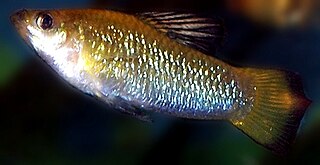
Perugia's limia is a small fish of the family Poeciliidae endemic to the Caribbean island of Hispaniola, where it occurs in streams.
The mesh-scaled topminnow is a species of fish in the family Poeciliidae. The two population groups are a southern group of populations found in Angola, Botswana, the Republic of the Congo, Malawi, Mozambique, and Zambia and a northern population group found in Chad, the Central African Republic, the White Nile in South Sudan and Sudan and in the northern Democratic Republic of Congo. Its natural habitat is small streams and brooks, lakes, and swamps on floodplains where it lives among aquatic vegetation. This species was described by George Albert Boulenger as Haplochilus hutereaui in 1913 with the type locality being Dungu on the upper Uelé River in the Democratic Republic of Congo. Boulenger received the type from Armand Hutereau (1875-1914), who was the head of a Belgian ethnographic expedition to the Congo, so he honoured Hutereau in the specific name.
The yellowfin gambusia is a species of fish in the family Poeciliidae. It is endemic to the Rio Conchos of Chihuahua, Mexico, where it is known as guayacon de san gregorio. This species was described in 1957 by Clark Hubbs and Victor G. Springer with the type locality given as El Ojo de San Gregorio in Chihuahua. The specific name of this fish honours the Mexican ichthyologist José Alvarez del Villar (1903-1986) for his work on the fishes of Mexico and for his assistance to Clark and Springer.
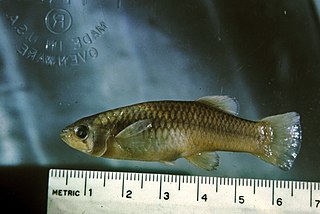
The Big Bend gambusia is a rare species of fish in the family Poeciliidae. It is endemic to the Big Bend region of the Rio Grande of the United States and Mexico. The only known remaining population is in a protected pond in the Big Bend National Park.
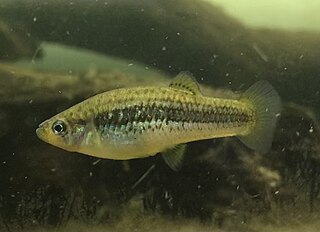
Gambusia hurtadoi, also known as crescent gambusia, is a species of fish in the family Poeciliidae. It is endemic to Chihuahua in Mexico, where it is known as guayacon de Hacienda Dolores. It grows to 3.5 cm (1.4 in) total length. The species was described in 1957 by Carl Leavitt Hubbs and Victor G. Springer with the type locality given as El Ojo de la Hacienda Dolores, 7 miles south of Jiminez, Chihuahua, the spring to which this species is endemic. Hubbs and Springer honoured the Mexican Leopoldo Hurtado Olin of the Departamento de Economía in Chihuahua for his assistance during their collecting expedition to Chihuahua in June 1951. Hurtado Olin also informed Hubbs and Springer of the location of El Ojo de la Hacienda Dolores.
The eastcoast lampeye is a species of fish in the family Poeciliidae. It is endemic to coastal Kenya and Tanzania, where found in brackish water, mangrove swamps, pools, lagoons and river deltas. It reaches up to 5 cm (2.0 in) in total length. This fish was described by Ernst Ahl as Haplochilichthys stuhlmanni with the type locality given as Tanganyika Territory. The specific name honours the co-leader of the German East Africa Expedition (1889-1892) on which type was collected, Franz Ludwig Stuhlmann (1863-1928) of the German Colonial Service.

Micropoecilia is a genus of poeciliids native to fresh and brackish water from the Amazon Basin to Trinidad. While recognized as valid by FishBase, others have considered this genus as being synonymous with Poecilia.
The Chiapas swordtail or upland swordtail is a species of livebearing freshwater fish of family Poeciliidae, and genus Xiphophorus. It is, therefore, in the same genus as the common platy and the swordtail. The Chiapas swordtail was discovered and first described by Donn E. Rosen in 1960, along with four other species of Xiphophorus.

The green swordtail is a species of freshwater/brackish fish in family Poeciliidae of order Cyprinodontiformes. A live-bearer, it is closely related to the southern platyfish or 'platy' (X. maculatus) and can crossbreed with it. It is native to an area of North and Central America stretching from Veracruz, Mexico, to northwestern Honduras.

Goodeinae is a subfamily of splitfins from Mexico, part of the family Goodeidae. They are small fish which mostly live in fresh water, especially around Mesa Central, west of Mexico City. Members of the subfamily are also found in brackish water on both the east and west coasts. They typically have small ranges and many are seriously threatened. The subfamily takes its name from its type genus Goodea and so is ultimately named after the American ichthyologist George Brown Goode (1851-1896).

Cubanichthys is a small genus of pupfishes endemic to the Caribbean Islands of Cuba and Jamaica. The name of this genus is a compound of Cuba, where the genus was thought to be endemic until C. pengellyi was placed in the genus, and the Greek word for fish, ichthys.

Alfaro is a genus of poeciliid fishes endemic to Central America. The generic name honours the Costa Rican archaeologist, geologist, ethnologist, zoologist and Director of the National Museum of Costa Rica, Anastasio Alfaro (1865-1951).
Carlhubbsia is a genus of poeciliids native to Guatemala and Mexico. The name of this genus honours the American ichthyologist Carl Leavitt Hubbs (1894-1979) who originally named the genus Allophallus, a name which was preoccupied by a genus of Diptera.
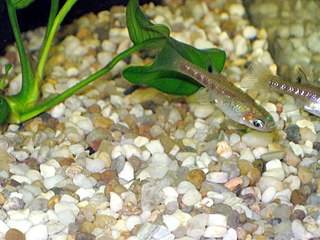
Girardinus is a genus of poeciliids native to Cuba. The name of this genus honours the French zoologist Charles Frédéric Girard (1822-1895) for his work on the freshwater fish of North America.
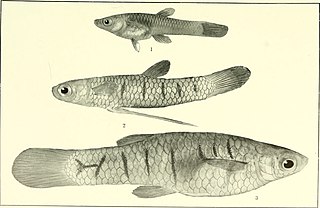
Pamphorichthys is a genus of poeciliids native to the Amazon, Paraguay, São Francisco and Itapicuru basins in South America.
Valencia robertae is a species of Mediterranean killifish, from the family Valenciidae. It is endemic to Greece where it is found in the Lower Pinios and lower Mornos Rivers in Greece. The species was described in 2004 with the type locality given as River Pinios south of Kavasila. The specific name honours the Italian ichthyologist Roberta Barbieri of the Hellenic Centre for Marine Research in Athens.

The Nile killifish, also known as the Nile lampeye, is a species of killifish from the family Poeciliidae. It is found in the White Nile drainage in Sudan, the Nile Delta in Egypt, the Wembere and Malagarasi Rivers in Tanzania and in the Lake Victoria basin in Uganda and Tanzania. However, it is thought to have been extirpated from Egypt, the introduction of alien poecilid fish, agricultural pollution and increasing salinity are all thought to have contributed to its local extinction in the Nile Delta.
Alfaro huberi is a species of livebearer in the family Poeciliidae, in the New World subfamily Poeciliinae. It is found in clear, fast flowing streams in Central America where it has been recorded from Honduras, Guatemala and Nicaragua. This fish was formally described in 1923 as Priapichthys huberi by Henry Weed Fowler with the type locality given as Marceligo Creek which is a tributary of the Río Tunky at Miranda in Nicaragua. The specific name honours the Curator of Mammals at the Academy of Natural Sciences of Philadelphia Wharton Huber (1877-1942), a colleague of Fowlers, who collected the type.
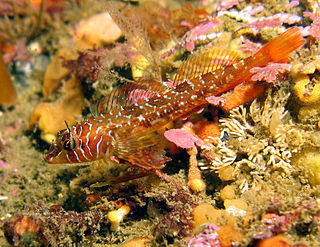
Jordaniidae is a small family of marine ray-finned fishes belonging to the order Scorpaeniformes. These fishes are found in the eastern North Pacific Ocean.













